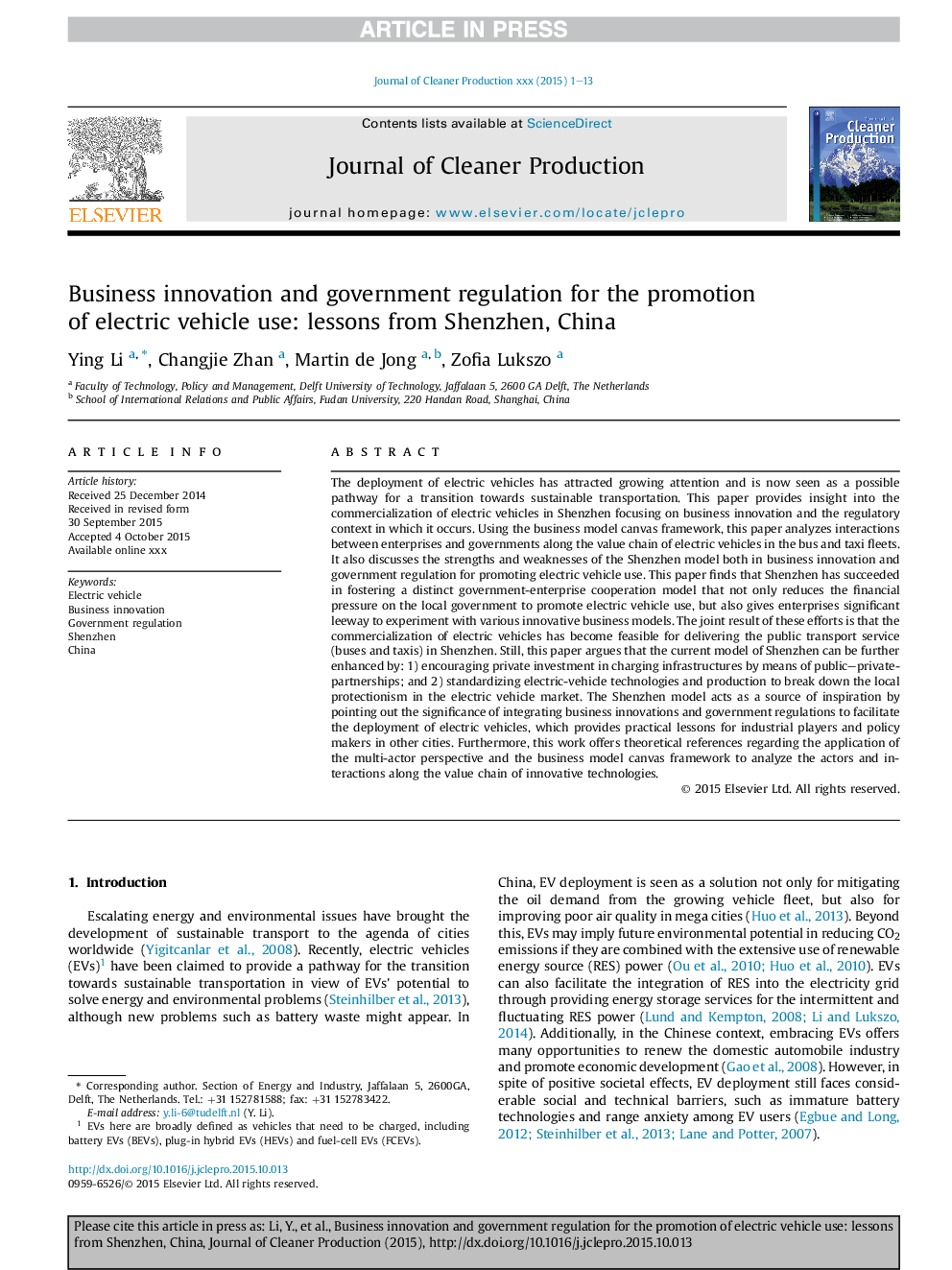| کد مقاله | کد نشریه | سال انتشار | مقاله انگلیسی | نسخه تمام متن |
|---|---|---|---|---|
| 10687799 | 1017948 | 2016 | 13 صفحه PDF | دانلود رایگان |
عنوان انگلیسی مقاله ISI
Business innovation and government regulation for the promotion of electric vehicle use: lessons from Shenzhen, China
ترجمه فارسی عنوان
نوآوری کسب و کار و مقررات دولتی برای ارتقاء استفاده از وسایل نقلیه الکتریکی: درس های شنزن، چین
دانلود مقاله + سفارش ترجمه
دانلود مقاله ISI انگلیسی
رایگان برای ایرانیان
کلمات کلیدی
خودرو الکتریکی، نوآوری کسب و کار، مقررات دولتی، شنژن، چین،
ترجمه چکیده
استقرار وسایل نقلیه الکتریکی توجه توجه بیشتری را جلب کرده است و اکنون به عنوان راهی برای انتقال به سوی حمل و نقل پایدار دیده می شود. این مقاله بینش تجاری در زمینه وسایل نقلیه الکتریکی در شنزن را متمرکز بر نوآوری کسب و کار و زمینه های قانونی که در آن رخ می دهد، فراهم می کند. با استفاده از مدل چارچوب مدل کسب و کار، این مقاله، تعاملات بین شرکت ها و دولت ها را در طول زنجیره ارزش وسایل نقلیه الکتریکی در ناوگان اتوبوس و تاکسی بررسی می کند. همچنین در مورد نقاط قوت و ضعف مدل شنژن هر دو در نوآوری کسب و کار و مقررات دولتی برای ترویج استفاده از وسایل نقلیه الکتریکی بحث می کند. این مقاله نشان می دهد که شنژن موفق به ایجاد یک مدل همکاری سازمانی دولتی و سازمانی شده است که نه تنها باعث کاهش فشار مالی بر دولت محلی برای ترویج استفاده از وسایل نقلیه الکتریکی می شود، بلکه باعث می شود که شرکت ها بتوانند با استفاده از مدل های نوآورانه تجاری مختلف اقدام به آزمایش کنند. نتیجه مشترک این تلاش ها این است که تجاری سازی وسیله نقلیه الکتریکی برای ارائه خدمات حمل و نقل عمومی (اتوبوس ها و تاکسی ها) در شنژن امکان پذیر است. با این حال، در این مقاله استدلال می شود که مدل فعلی شنزن را می توان با افزایش: 1) تشویق سرمایه گذاری خصوصی در شارژ زیرساخت ها با استفاده از مشارکت دولتی و خصوصی؛ و 2) استاندارد سازی تکنولوژی و وسایل نقلیه الکتریکی و تولید برای شکستن حمایت های محلی در بازار خودرو الکتریکی. مدل شنژن به عنوان یک منبع الهام بخش با اشاره به اهمیت ادغام نوآوری های کسب و کار و مقررات دولتی برای تسهیل استقرار وسیله نقلیه الکتریکی، که درس های عملی برای بازیکنان صنعت و سیاست گذاران در شهرهای دیگر را فراهم می کند. علاوه بر این، این مقاله ارایه دهنده های نظری در مورد استفاده از چشم انداز چند شخصیت و چارچوب مدل کسب و کار مدل برای تجزیه و تحلیل بازیگران و تعاملات در طول زنجیره ارزش از فن آوری های نوآورانه است.
موضوعات مرتبط
مهندسی و علوم پایه
مهندسی انرژی
انرژی های تجدید پذیر، توسعه پایدار و محیط زیست
چکیده انگلیسی
The deployment of electric vehicles has attracted growing attention and is now seen as a possible pathway for a transition towards sustainable transportation. This paper provides insight into the commercialization of electric vehicles in Shenzhen focusing on business innovation and the regulatory context in which it occurs. Using the business model canvas framework, this paper analyzes interactions between enterprises and governments along the value chain of electric vehicles in the bus and taxi fleets. It also discusses the strengths and weaknesses of the Shenzhen model both in business innovation and government regulation for promoting electric vehicle use. This paper finds that Shenzhen has succeeded in fostering a distinct government-enterprise cooperation model that not only reduces the financial pressure on the local government to promote electric vehicle use, but also gives enterprises significant leeway to experiment with various innovative business models. The joint result of these efforts is that the commercialization of electric vehicles has become feasible for delivering the public transport service (buses and taxis) in Shenzhen. Still, this paper argues that the current model of Shenzhen can be further enhanced by: 1) encouraging private investment in charging infrastructures by means of public-private-partnerships; and 2) standardizing electric-vehicle technologies and production to break down the local protectionism in the electric vehicle market. The Shenzhen model acts as a source of inspiration by pointing out the significance of integrating business innovations and government regulations to facilitate the deployment of electric vehicles, which provides practical lessons for industrial players and policy makers in other cities. Furthermore, this work offers theoretical references regarding the application of the multi-actor perspective and the business model canvas framework to analyze the actors and interactions along the value chain of innovative technologies.
ناشر
Database: Elsevier - ScienceDirect (ساینس دایرکت)
Journal: Journal of Cleaner Production - Volume 134, Part A, 15 October 2016, Pages 371-383
Journal: Journal of Cleaner Production - Volume 134, Part A, 15 October 2016, Pages 371-383
نویسندگان
Ying Li, Changjie Zhan, Martin de Jong, Zofia Lukszo,
